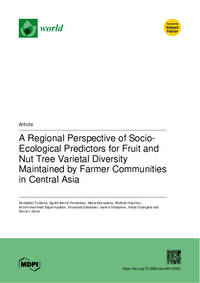A Regional Perspective of Socio-Ecological Predictors for Fruit and Nut Tree Varietal Diversity Maintained by Farmer Communities in Central Asia

Authors:
The five independent countries of Central Asia, namely Kazakhstan, Kyrgyzstan, Tajikistan, Turkmenistan, and Uzbekistan, contain one of the richest areas in the world for the specific and intraspecific diversity of temperate fruit and nut tree species. Research was carried out via the collaboration of national research and education institutes with local community-based agencies and farmer communities. Raw data (2014 observations) for almond, apple, apricot, cherry plum, currant, grapevine, pear, pomegranate, and walnut were collected at the household (HH) level across the five countries: Uzbekistan, Kazakhstan, Tajikistan, Turkmenistan, and Kyrgyzstan. A set of models was used, including household variety richness as the dependent variable, to understand the influence of socio-ecological variables on the amount and distribution of crop varietal diversity in the farmers’ production systems. Four variables were included as explanatory variables of variety richness (fixed factors): ecoregion, ethno-linguistic group, management, and abiotic stress. The results show clear
evidence that abiotic stress determines a higher richness of intra-specific diversity in the form of local varieties grown by farmers living in climatically unfavorable areas. The results for the studied ecoregions follow the same trend, with ecoregions with harsher conditions displaying a higher positive correlation with diversity. Mild environments such as the Central Asian riparian woodlands show an unexpectedly lower diversity than other harsher ecoregions. Ethno-linguistic groups also have an effect on the level of varietal diversity used, related to both historic nomadic practices and a culture of harvesting wild fruit and nuts in mountainous areas. The home garden management system hosts a higher diversity compared to larger production systems such as orchards. In Central Asia, encouraging the cultivation of local varieties of fruit and nut trees provides a key productive and resilient livelihood strategy for farmers living under the harsh environmental conditions of the region while providing a unique opportunity to conserve a genetic heritage of global importance.
